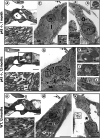Exacerbated age-related hearing loss in mice lacking the p43 mitochondrial T3 receptor
- PMID: 33526032
- PMCID: PMC7852282
- DOI: 10.1186/s12915-021-00953-1
Exacerbated age-related hearing loss in mice lacking the p43 mitochondrial T3 receptor
Abstract
Background: Age-related hearing loss (ARHL), also known as presbycusis, is the most common sensory impairment seen in elderly people. However, the cochlear aging process does not affect people uniformly, suggesting that both genetic and environmental (e.g., noise, ototoxic drugs) factors and their interaction may influence the onset and severity of ARHL. Considering the potential links between thyroid hormone, mitochondrial activity, and hearing, here, we probed the role of p43, a N-terminally truncated and ligand-binding form of the nuclear receptor TRα1, in hearing function and in the maintenance of hearing during aging in p43-/- mice through complementary approaches, including in vivo electrophysiological recording, ultrastructural assessments, biochemistry, and molecular biology.
Results: We found that the p43-/- mice exhibit no obvious hearing loss in juvenile stages, but that these mice developed a premature, and more severe, ARHL resulting from the loss of cochlear sensory outer and inner hair cells and degeneration of spiral ganglion neurons. Exacerbated ARHL in p43-/- mice was associated with the early occurrence of a drastic fall of SIRT1 expression, together with an imbalance between pro-apoptotic Bax, p53 expression, and anti-apoptotic Bcl2 expression, as well as an increase in mitochondrial dysfunction, oxidative stress, and inflammatory process. Finally, p43-/- mice were also more vulnerable to noise-induced hearing loss.
Conclusions: These results demonstrate for the first time a requirement for p43 in the maintenance of hearing during aging and highlight the need to probe the potential link between human THRA gene polymorphisms and/or mutations and accelerated age-related deafness or some adult-onset syndromic deafness.
Keywords: Age-related hearing loss; Mitochondrial dysfunction; Thyroid hormones; p43 mitochondrial T3 receptor.
Conflict of interest statement
The authors declare having no competing interests.
Figures






Similar articles
-
Codeficiency of Lysosomal Mucolipins 3 and 1 in Cochlear Hair Cells Diminishes Outer Hair Cell Longevity and Accelerates Age-Related Hearing Loss.J Neurosci. 2018 Mar 28;38(13):3177-3189. doi: 10.1523/JNEUROSCI.3368-17.2018. Epub 2018 Feb 16. J Neurosci. 2018. PMID: 29453205 Free PMC article.
-
Pathology and mechanisms of cochlear aging.J Neurosci Res. 2020 Sep;98(9):1674-1684. doi: 10.1002/jnr.24439. Epub 2019 May 7. J Neurosci Res. 2020. PMID: 31066107 Free PMC article. Review.
-
Cellular correlates of progressive hearing loss in 129S6/SvEv mice.J Comp Neurol. 2004 Feb 9;469(3):377-90. doi: 10.1002/cne.11011. J Comp Neurol. 2004. PMID: 14730589
-
Mice lacking the p43 mitochondrial T3 receptor become glucose intolerant and insulin resistant during aging.PLoS One. 2013 Sep 30;8(9):e75111. doi: 10.1371/journal.pone.0075111. eCollection 2013. PLoS One. 2013. PMID: 24098680 Free PMC article.
-
Role of antioxidants in prevention of age-related hearing loss: a review of literature.Eur Arch Otorhinolaryngol. 2017 Apr;274(4):1821-1834. doi: 10.1007/s00405-016-4378-6. Epub 2016 Nov 17. Eur Arch Otorhinolaryngol. 2017. PMID: 27858145 Review.
Cited by
-
Impacts of impaired mitochondrial dynamics in hearing loss: Potential therapeutic targets.Front Neurosci. 2022 Oct 5;16:998507. doi: 10.3389/fnins.2022.998507. eCollection 2022. Front Neurosci. 2022. PMID: 36278017 Free PMC article. Review.
-
Oxidative Stress Plays an Important Role in Glutamatergic Excitotoxicity-Induced Cochlear Synaptopathy: Implication for Therapeutic Molecules Screening.Antioxidants (Basel). 2024 Jan 25;13(2):149. doi: 10.3390/antiox13020149. Antioxidants (Basel). 2024. PMID: 38397748 Free PMC article.
-
Tentative Application of a Streamlined Protocol to Determine Organ-Specific Regulations of Deiodinase 1 and Dehalogenase Activities as Readouts of the Hypothalamus-Pituitary-Thyroid-Periphery-Axis.Front Toxicol. 2022 Mar 21;4:822993. doi: 10.3389/ftox.2022.822993. eCollection 2022. Front Toxicol. 2022. PMID: 35387426 Free PMC article.
-
Wfs1E864K knock-in mice illuminate the fundamental role of Wfs1 in endocochlear potential production.Cell Death Dis. 2023 Jun 29;14(6):387. doi: 10.1038/s41419-023-05912-y. Cell Death Dis. 2023. PMID: 37386014 Free PMC article.
-
Novel insights into mechanisms and therapeutics for presbycusis.Heliyon. 2024 Dec 14;11(1):e41203. doi: 10.1016/j.heliyon.2024.e41203. eCollection 2025 Jan 15. Heliyon. 2024. PMID: 39807511 Free PMC article. Review.
References
-
- Ng L, Kelley MW, Forrest D. Making sense with thyroid hormone--the role of T (3) in auditory development. Nat Rev Endocrinol. 2013;9(5):296–307. - PubMed
-
- Wrutniak-Cabello C, Casas F, Cabello G. Thyroid hormone action in mitochondria. J Mol Endocrinol. 2001;26(1):67–77. - PubMed
-
- Lautermann J, ten Cate WJ. Postnatal expression of the alpha-thyroid hormone receptor in the rat cochlea. Hear Res. 1997;107(1–2):23–28. - PubMed
Publication types
MeSH terms
Substances
Grants and funding
LinkOut - more resources
Full Text Sources
Other Literature Sources
Medical
Molecular Biology Databases
Research Materials
Miscellaneous

